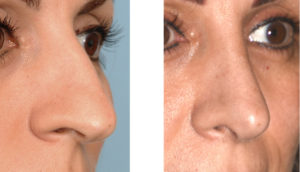Rhinoplasty is an operation that is requested across all races and cultures. Each race to a large degree has inherent features that make it distinct from a traditional Caucasian nose. The Middle Eastern nose is no exception . While the concept of Middle Eastern is a cultural blend of many people that have become intertwined over thousands of years, it does possesses some consistent characteristics that can be altered by rhinoplasty surgery.
In the April 2009 issue of Plastic and Reconstructive Surgery, a paper was published that detailed out the Middle Eastern nose and a sound rhinoplastic approach to it. The most common Middle Eastern nasal characteristics include wide nasal bones, a high dorsum and an overprojecting radix, a downward oriented nasal tip that is wide and bulbous, and nostrils that may be flared. This nasal framework is covered by thick oily skin that has some excess fat at the tip.

Because of the thick nasal skin, prolonged swelling after surgery may take some time to settle down. This is particularly true in the tip of the nose. Prolonged swelling and the formation of scar tissue in the tip may require secondary revisional surgery to get the most refined result.
Dr. Barry Eppley
Indianapolis, Indiana


